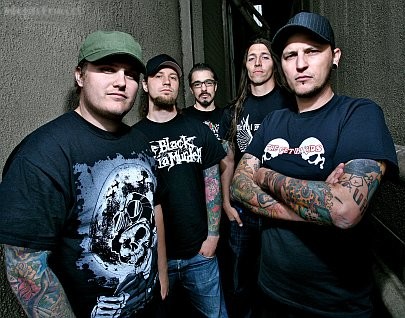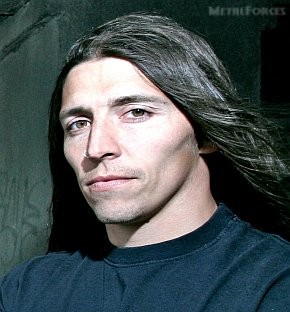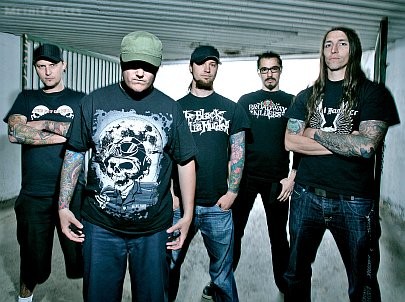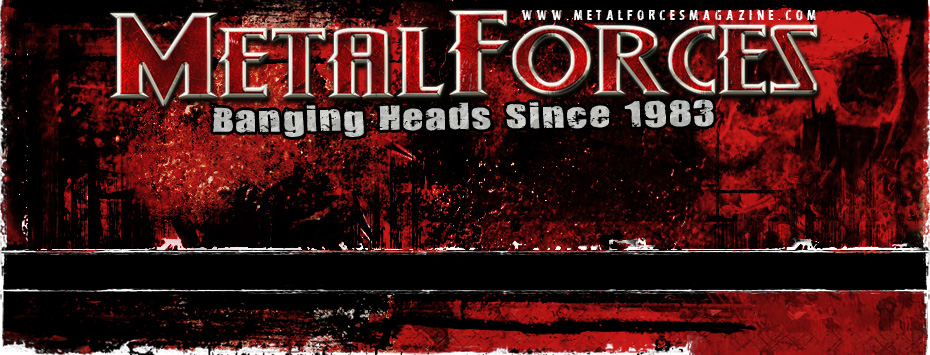
HATESPHERE – Resurrected With A Vengeance
Anthony Morgan
January 2012

|
Aarhus, Denmark-based extreme metal outfit HateSphere issued sixth studio full-length To The Nines in March 2009, its release arriving through Napalm Records. Drummer Dennis Buhl departed from the group as the result of reportedly severe back problems, his exit as well as replacement in ex-Mercenary sticksman Mike Park being announced on December 16th. February 23rd, 2010 brought news of vocalist Jonathan ‘Joller’ Albrechtsen’s departure, and subsequently on June 30th Esben ‘Esse’ Hansen (As We Fight) was revealed to be HateSphere’s new vocalist. The exit of bassist Mixen Lindberg was made public that same day, and it wasn’t until May 27th, 2011 that a replacement in Jimmy Nedergaard (ex-Gob Squad) publicly came to light.
“After the previous album was released, we only did six months of touring and then our drummer told us that he was leaving,” remembers Peter ‘Pepe’ Lyse Hansen, guitarist and founder of HateSphere. “We then immediately started searching, and actually before we got our old drummer in the band we also tried to get Mike in the band at that time as well. He was playing with Mercenary, another Danish band which were quite successful. He didn’t want to leave them at that time but this time he wanted to leave though; he still liked HateSphere, and wanted play with us. That was in November 2009 when he joined the band, and shortly after our singer Jonathan told us that he was leaving. Jonathan just wanted to do something else –. he’s got another band. He’s very young, way younger than we are. You have to fit together as people as well, and he was – in my opinion – a bit young when he joined the band. He’s got his views on things, and we’ve got other views on things. At some point he just wanted to do something else. He didn’t like the music as much, and he had another band with all his old friends and wanted to do that.
“We had two US tours last year, and on the first US tour we had a stand-in singer (Morten ‘Kruge’ Madsen of Mevadio). He played that tour plus another festival thing, and then we started searching for another singer to join the line-up. We found Esse who joined the band in June 2010, who we knew before. He’s younger than we are, but not that much younger. He’s been in the Danish metal scene for about ten years, so he’s not new. He comes from a similar background and was a HateSphere fan before he joined, so he knows as well how we want HateSphere to sound. He’s just an excellent singer; he can do everything with his voice, kind of.
“Actually right before Esse joined our bass player told us as well that he wanted to leave, so he left the band as well. For a time we had Mikael (Hansen) back in the band, and Esse joined the band just after that. We had to decide if we wanted to find a steady bass player right away, or go with a stand-in solution for awhile before we started writing the new album and find the right guy for the job. Luckily for us, our old bass player Mikael joined the band for six months and played with us in the US, Europe.
“We then found Jimmy while we were writing the new album, so finding our singer and drummer happened at the same time. We got a drummer in the band quickly, but we had a stand-in solution for the vocals and bass for awhile before we actually found the right guys. We don’t wanna rush into things I guess, and have to replace members shortly afterwards. Like I said, with Esse, our new bass player Jimmy and our drummer Mike – a new line-up compared to the previous album – all of them are old HateSphere fans. We’ve got kind of the same background. We didn’t have that background with Jonathan, and that can be a cool thing or a bad thing. In the end, it wasn’t that good because he wanted to do something different. If you join the band today, you have to want to do the same things.”

|
“We don’t wanna change any more members. We’re gonna try to not change any more members (laughs), because we don’t want all that hassle. We hate it, but it’s been necessary. We wanted to find the right guy, and it’s not that easy in Denmark. We talked about getting a foreign guy in the band, but it just wouldn’t fit us people. It’s way easier for us to all live in Denmark and all speak the same language and all with the same background instead of having to fly in a singer from another country every time we have a show. It’s quite stressful, and we don’t want any more stress. We took it nice and easy, and found the members. After we found Esse, it was actually only a bass player we needed to find.”
Initial writing sessions for seventh studio outing proper The Great Bludgeoning began in December 2010. “At that time we were just a four-piece; we didn’t have a bass player at the time,” the axeman recalls. “We actually wrote five to six songs on the album before we got a bass player. Jimmy joined the band in April and we went into the studio in June 2011, so it was pretty hectic but a nice experience. The line-up is new again, but this line-up feels really good.”
“He’s quite varied, so he can do everything,” Pepe reckons of Esse. “On the album he goes deep and high. He’s got things right, so he knows what he’s doing. He’s good at writing hook lines, he’s good at spotting how he’s gonna sing on the riffs and in the songs, and he’s good at writing lyrics actually. He’s got a lot of good ideas that are within the HateSphere universe, and in that respect he’s – in my opinion – the most varied singer that we’ve ever had.”
Violence and hate are lyrical themes which surface on The Great Bludgeoning. “It’s not that simple though,” the mainman stresses. “‘The Killer’ is about a certain guy who went to jail for a crime that he didn’t commit, for murdering his wife. He read the story of how he eventually got free again and then actually killed himself, so he’s actually writing about the darker side of the human mind and the darker side of human actions, which is what we’ve always been doing.”
Given HateSphere’s line-up changes between the release of To The Nines and The Great Bludgeoning, it would be arguably fair to surmise HateSphere’s sound has altered somewhat. “I don’t think the sound itself has changed that much,” Pepe believes though. “Every time we do a new album, we don’t wanna repeat ourselves. You can always hear that it’s HateSphere and that’s the cool thing with the new line-up, that you can still hear that it’s HateSphere. We want to do more new things every time we do a new album, but we don’t want to change our style totally because this is who we are. I think this new one is more old-school, and it’s fresher. We got a new drummer and a new vocalist, and those guys have had a lot of impact on the sound actually. Mike is more rock-oriented so the sound is dirtier in my opinion. Rawer, more real. I think it’s way more varied than our previous albums as well, so all in all it’s more varied I think. Rawer. The new line-up really know how we wanna sound, and how we’re gonna sound. This new album is fresh like I said, and I find it really, really good. We are very satisfied with how it’s turned out, how the sound is, how fresh it is. We like it and we think that HateSphere sounds better than ever, actually. We still pull together, and we still sound like HateSphere. The new line-up has really been a good thing.”
The Great Bludgeoning’s aforementioned rawness suggests the album is more resemblant of HateSphere in a live setting. “That’s actually true, because what we told our producer Tue this time is that we wanted to sound real,” the guitarist discloses. “We’ve never wanted to use sound replacements and stuff; I hate many of the new metal sounds, because they just sound like shit. They don’t sound real to me. We wanted to sound real. I tried to tell him as well that we really liked the sound on Ballet Of The Brute (June 2004), and we tried to orientate the sound as well. I think we did that pretty well. As you said yourself, I think the album has way more similarities to us in a live setting and that’s a very good thing in my opinion.”

|
HateSphere’s working relationship with Tue Madsen stretches back as far as 1997, when the man produced the assortment’s sophomore demo tape. “It’s been a long time that we’ve been working on and off,” Pepe admits. “For my part though, he lives just a minute away on bike from where I live. His studio is there and it’s very relaxed. We all know each other, so we can fool around and have a relaxed atmosphere while recording. Still Tue will be professional though, and we’re not fooling around so much that we can’t make an album. On the contrary, I think the albums turn out really, really good and that’s because we know each other, we’re relaxed, and we want a relaxed atmosphere when we’re recording. Otherwise it isn’t funny, and it needs to be funny. Being in the studio especially isn’t cool (laughs), but it’s cool to go out and play afterwards. This time around it was a really good experience though. It’s been like that before actually, but it was just way, way more relaxed this time. A lot of people joined us in the studio to hang out, and it was cool to work with him again.”
Tue Madsen seems to be one of the go to producers for Danish metal groups. “He is, and not only in Denmark but for metal in general,” the HateSphere founder adds. “He’s busy with well-known metal bands from all around the world, and that’s a cool thing as well I think.”
Pepe feels that the record’s guitar sound is “way more old school than on our previous albums. We like bands that still have a lot of groovy and slower elements mixed into their music. We like the groovy parts, so this is always mixed in with the fast stuff. Playing only fast gets really boring after awhile, so mixing in the fast stuff with the groovy, slower stuff makes it more interesting. I think that’s what we’ll do again, play groovy stuff and use those newer elements like acoustic intros and orchestral work and some hard rock riffs as well. We actually got a song on the album called ‘Need To Kill’ that’s really a hard rock, death / thrash song; it doesn’t sound that hard rock, but it has quite a lot of hard rock riffs in it. It’s the closest thing to hard rock we’ve recorded so far. My guitar work is a mixture of fast, slow, and groovy, and it sounds real.”
Mnemic founder and guitarist Mircea Gabriel Eftemie designed the cover artwork for The Great Bludgeoning. “We find him really good,” the axeman enthuses. “We wanted to go more old school with this album’s cover artwork, so we told him we wanted a more old school, metal artwork with the right colours.”
The Great Bludgeoning was released in Europe on September 23rd, 2011 and subsequently in North America on the 27th, all through Napalm Records.
Interview published in January 2012.
Related Posts via Categories
- SCOTTISH SICKNESS – A Report On The Scottish Death Metal Scene, Featuring BRAINBATH, PUTRID FATE And RANCID CADAVER (October 2022) | Features / Interviews @ Metal Forces
- LARVAE – Join The Hardcore Cult! (June 2022) | Features / Interviews @ Metal Forces Magazine
- TRENCH FOOT – Sacrificing Morals For Gory Obscenities (June 2022) | Features / Interviews @ Metal Forces Magazine
- L.A. GUNS – Trigger Happy (March 2019) | Features / Interviews @ Metal Forces Magazine
- CANCER – Crimes So Evil (November 2018) | Features / Interviews @ Metal Forces Magazine
- U.D.O. – The Tank Drives On (August 2018) | Features / Interviews @ Metal Forces Magazine
- SIEGE OF POWER – Bleeding For The Cause (August 2018) | Features / Interviews @ Metal Forces Magazine
- MOONSPELL – A Taste Of Live Eternity (August 2018) | Features / Interviews @ Metal Forces Magazine
- MONSTROSITY – Dark Matter Invocation (August 2018) | Features / Interviews @ Metal Forces Magazine
- SATAN – Five Magicians (August 2018) | Features / Interviews @ Metal Forces Magazine
|
|





